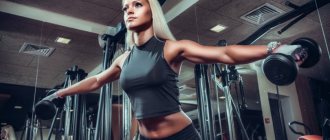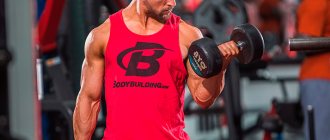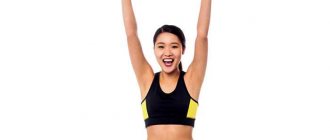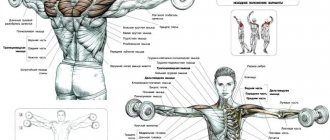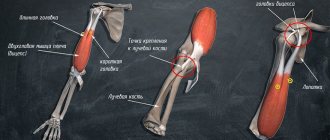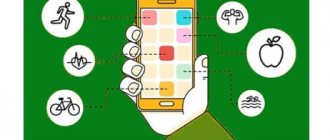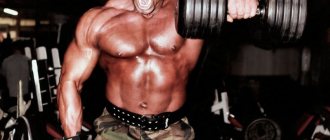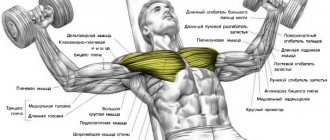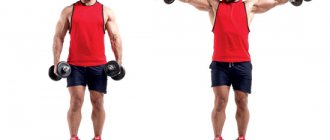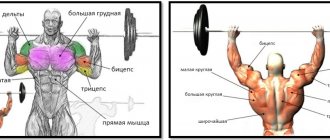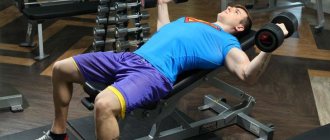Dumbbell press features
The dumbbell press is biomechanically very similar to the classic standing press and the barbell overhead press. However, there are significant differences in these exercises. Let's look into them.
The amplitude of movement during the dumbbell press is significantly greater than in the standing press, and even more so than in the overhead press. The greater the range of motion, the more work the muscles do. This is a definite plus.
When performing a dumbbell press, your shoulder and elbow joints are in a safer position. There is no binding to one position, one trajectory, the movement is more natural.
It is worth saying that the dumbbell press perfectly works the entire layer of muscle fibers of the shoulder (though excluding the posterior bundle). An undoubted advantage is the ability to work with heavy dumbbells.
Due to the absence of a barbell, you have to constantly balance the dumbbells. Stabilizing muscles are involved in the work. It turns out that in this exercise many more muscle groups work than in barbell presses. Again a plus.
However, everything good has its downsides. The presence of dumbbells and the need to control their balance forces you to use less weight than you could lift in a barbell press. The muscles are forced to do more work, so you can never repeat the maximum weight squeezed on a barbell with dumbbells.
Another disadvantage is the difficulty of progression of the load when you get to heavy dumbbells. The pitch of dumbbell weights in modern gyms is very spread out. Dumbbells of 35 kg may be followed by 40 kg or even more. The higher the weight of your dumbbells, the more difficult it will be to add small weights.
The way out of this situation is as follows. Build your training plan so that the main basic exercise for the shoulders is the standing barbell press from the chest. At an advanced level, add dumbbell presses to it.
Standing dumbbell press technique
Before directly starting the dumbbell press itself, it is imperative to carry out general stretching for all muscle groups of the upper shoulder girdle and pay special attention to warming up the rotator cuff muscles. You can also do a couple of warm-up sets of bench presses with very light weights.
Hold a dumbbell in each hand with an overhand grip.
Straighten your back, leaving a slight arch in the lower back, straighten your chest, and pull your shoulders back. Place your feet shoulder-width apart, with your feet slightly turned outward.
Tighten your abs and spine and keep your torso motionless throughout the entire set. The work will be performed using the strength of the shoulder muscles.
Starting position: place dumbbells at shoulder level (hands slightly wider than shoulders), palms turned outward. The forearms are parallel to each other.
The head is fixed, the gaze is directed straight ahead.
Take a deep breath and, holding your breath, begin to press the dumbbells in a straight line upward (towards the ceiling) until your arms are fully straightened at the elbow joints.
At the top of the movement, the projectiles should touch each other. The conditional line connecting the two dumbbells will pass through the head. Holding for a second in the upper phase will allow you to feel the maximum tension of the muscles being worked.
Saddle exhale and smoothly return to the starting position along the same trajectory of movement. Without stopping or relaxing, begin the upward movement again.
Do the planned number of repetitions.
Muscles involved in the exercise
The exercise involves the muscles of the shoulder, shoulder girdle and elbow joint. Deltoid muscle - starts from the outer third of the clavicle and the spine of the scapula, and is attached to the deltoid tuberosity of the humerus.
Supraspinatus muscle - lies under the deltoid muscle in the supraspinatus fossa of the scapula, attached to the greater tubercle of the humerus and the capsule of the shoulder joint.
The muscles of the shoulder girdle include the trapezius muscle and the serratus muscle (serratus anterior). The trapezoid begins at the base of the skull, from the external occipital protuberance and the 7th cervical and upper thoracic vertebrae. Attached to the outer end of the clavicle and the upper edge of the clavicle. The serratus muscle starts from the first five thoracic vertebrae and is attached to the medial edge of the scapula.
The movement of the scapula involves the uppermost part of the trapezius, the levator scapulae and the rhomboid muscles. The diamond shape is located under the middle part of the trapezius, in the middle of the back. It starts from the two lower cervical vertebrae and is attached to the medial edge of the scapula. The levator scapulae is a small muscle on the back of the neck, located under the upper part of the trapezius muscle. It runs from the upper cervical vertebrae to the upper corner of the scapula.
Of the muscles of the elbow joint, only the triceps, a large muscle that completely covers the upper part of the arm, is involved in the exercise. The triceps is divided into three heads - lateral, middle and long, but that's another story...
Swing dumbbells to the sides while standing
To develop the middle deltoids, athletes include standing dumbbell swings performed from a standing position in their training program. This muscle group is the main one in this exercise. In addition, there is a load on both the trapezius and rear deltoids. The degree of difficulty of this exercise is average, but quite a lot of mistakes can be made in the technique of performing it.
Lifting dumbbells while standing laterally is considered one of the best ways to work the middle delta, but it requires a clear understanding of the correct technique. The absence of mistakes when performing this exercise allows you to ensure that your shoulders become as broad as possible. The development of deltoid muscles is one of the highest priority areas in which athletes work when visiting the gym. Powerful shoulders make the athlete’s figure as wide as possible from the side, emphasize the upper part of the arms, and allow others to tell others how serious the attitude of a bodybuilder with such powerful and developed shoulders is.
Some athletes prefer a basic exercise like the overhead press to swings. It certainly brings certain benefits, since it is intended for training the shoulder girdle, but, being the main one, it does not have the same effect on the middle deltoids. The latter are worked out in the process of swinging dumbbells to the sides from a standing position, since this exercise works this part of the shoulders in isolation.
Muscles involved in the exercise
The standing barbell press is a basic exercise, that is, when performing it, several joints are involved in the work, namely the shoulder and elbow, respectively, several muscle groups receive a load. In addition to the deltoid muscles, which bear the main load, the triceps of the arms, the extension of the arms at the elbow joints, as well as the upper pectoral muscles receive additional load. The abdominal, back, and leg muscles take part in the exercise as stabilizer muscles. These muscles have an auxiliary role in maintaining body position while performing a barbell press.
Difficulty level: recommended for both experienced athletes and beginners;
Since the standing barbell press (or military press) is a basic exercise, it should be performed at the beginning of training the deltoid muscles. The exercise is very effective for developing strength and mass not only in the shoulders, but also in the muscles of the whole body. However, we should not forget that the standing barbell press, especially its version with lowering the barbell behind the head, is one of the most traumatic exercises, since, firstly, in this exercise there is a high load on the joints, namely the knees, elbows and hips, - secondly, increased load on the lower back, and thirdly, injuries due to loss of balance or control over the barbell. Therefore, when performing a standing barbell press, it is strictly recommended to follow the correct technique for performing the exercise, which will avoid injuries, sprains and other pain.
Exercise technique:
- Before performing the exercise, stretch and thoroughly warm up your shoulder joints. Place the barbell in the power rack at a height near your chest or slightly lower in order to conveniently remove it from the racks while holding the barbell on your chest. Once you've set the weights, grab the barbell using a pronated (palms facing up) grip that's slightly wider than shoulder-width apart.
- Bend your knees slightly, go under the barbell and place the barbell on your collarbones. Remove the barbell from the racks, firmly fixing its position lying on your chest. Take a step back and place your feet parallel to each other, shoulder-width apart. The gaze is directed forward.
- After you have removed the barbell and secured it to your chest, as you exhale, lift the barbell up above your head, straightening your arms. Hold it at shoulder level and slightly in front of your head.
- As you inhale, slowly lower the barbell down onto your collarbones, bending your knees slightly for shock absorption as you make contact.
- It is recommended to perform 8-10 repetitions for 3-4 sets.
Tips for implementation:
When lifting the barbell, you need to move your shoulders back a little, and, on the contrary, move your chest forward a little, thus maintaining the correct curve of the spine. When lifting the barbell, your arms need to be fully straightened
It is not advisable to lower the barbell below the clavicular cavity. It is important to keep your body straight, without leaning too far back, otherwise you will not be able to create normal support for performing the exercise. Only a slight deviation back is allowed when lifting the barbell up. You should not use excessive weights, since in this case the correct technique for performing the exercise is disrupted, balance may be disrupted and control over the barbell may be lost, in addition, this is a large load on the joints and ligaments, which is best avoided. The barbell must be pressed strictly above your head, and not in front of you. Periodically pay attention to the flexibility of your shoulder joints and warm them up properly. The standing chest press is not recommended for people who have problems with the spine or shoulder girdle.
It would be best to consult a doctor before starting this exercise. When performing a standing barbell press, try not to bend your lower back excessively, as this can lead to injury. Select a working weight that allows you to perform the exercise with the correct technique, without feeling discomfort in your shoulders or lower back.
Execution options:
Seated barbell press (military press)
The exercise can also be performed while sitting, using a bench, adjusting its inclination to 90 degrees and pressing your back against it. This will avoid unnecessary stress on the lower back for people who have problems with it, and will also exclude stabilizer muscles from the work, in particular the legs and back. Therefore, the seated barbell press is easier and safer to perform.
- Another option is to use dumbbells when performing this exercise for better isolation.
- The exercise can also be performed using a special simulator.
Video: Seated chest press:
Raising dumbbells overhead from the sides
Place your feet shoulder-width apart and straighten your torso. In the starting position, the arms are slightly bent and fixed at the elbows until the end of the set, the dumbbells almost touch the hips (palms facing the lateral surface of the thigh). Inhale and, holding your breath, raise your arms through your sides (strictly in the plane of your torso) above your head. When the dumbbells pass shoulder level, the arms turn slightly at the shoulder joint and at the top of the palm are directed forward. However, if it is uncomfortable for you to continue the movement when your arms become parallel to the floor and the dumbbells “get stuck,” turn your arms more strongly - palms up. In this case, at the top point the palms face each other. Do not relax your lower back and maintain a straight body position until the end of the set. Lower your arms down smoothly, as you exhale, controlling the dumbbells at each point of the movement. Don't bend your elbows! Perform the exercise at a moderate pace. The only exception is the bottom point, here slight acceleration is allowed to move the dumbbells from their place and begin the rise.
Recommendations Most athletes ignore this exercise, replacing it with lateral raises to shoulder level (dumbbell flyes). This is a mistake; by constantly practicing the exercise at half the amplitude, you overload the shoulder joint, provoke the development of its stiffness and, moreover, never reduce the deltoids to the maximum. The purpose of the exercise is the middle deltoids. They begin to play first fiddle as soon as the angle between the arm and the torso is 30 degrees, and reach the peak of muscle contraction at the moment when the arm is 45 degrees above the horizontal. Use only such a working weight that will allow you to perform the exercise technically correctly and to its full amplitude. Keep in mind: Heavy dumbbells will force you to bend your elbows and/or shorten your range of motion, which will significantly reduce the load on your deltoids. Hold your breath while lifting the dumbbells. Exhaling prematurely will cause your back muscles to relax, making it difficult to complete the dumbbell lift while keeping your back straight. This exercise can be performed in a crossover by attaching the handles to the cables passing through its lower blocks. However, this option is less effective, since after the handles pass shoulder level, the load on the deltoids is significantly weakened. {banner_st-d-2}
Application To: Everyone, from beginner to expert. When: In the middle of a shoulder workout. Before doing dumbbell overhead lateral raises, perform seated/standing dumbbell/barbell presses. Afterwards - bent-over dumbbell flyes and/or reverse flyes in the Peck-Deck simulator. How much: 3-4 sets of 10-12 repetitions.
Sports Raising dumbbells overhead from the sides specifically hits the middle fascicles of the deltoid muscle, the development of which visually widens and raises the shoulders. This exercise effectively highlights the middle deltoids, against the background of other bundles of the deltoid muscle, trapezius and triceps. In addition, lateral raises of dumbbells improve the mobility of the shoulder joint and strengthen the shoulder girdle as a whole.
Be sure to include this exercise in your strength training program if you play volleyball, tennis, swimming or martial arts.
Recommendations for performing the basic exercise
The most important thing is to prevent injury to the spine while lifting weights. The most important rule when doing a standing press is to strain your back and abs muscles as much as possible. It is also necessary to select the optimal weight of the shells. There is no need to show excessive fanaticism in this matter. If you notice that the front delta is not sufficiently worked out when lifting shells, then the matter is not at all in the working weight, but in the position of the palms and hands - at the lowest point they should look at each other. The palms should be turned out as much as possible to provide the necessary muscle stretch.
Also, you should not stop to rest when the exercises are at the lowest point (at ear level), this will reduce the amplitude and efficiency of the press. The frequency of movements should be constant and as wide as possible; this is the only way to effectively work out muscle groups.
When the projectiles are at the highest point above your head, you need to straighten your arms as much as possible, almost all the way
Beginners need to monitor the synchronization of hand movements, this is very important. Only by following the correct technique for performing the exercise can you achieve impressive results and avoid injuries.
Additional recommendations to follow:
- use collapsible equipment when you train at home - this will allow you to experiment with working weights, gradually adding them;
- if the development of deltas is a priority, in this case it is necessary to squeeze the projectile with one hand at the last repetition;
- a change in posture will reduce the effectiveness of this exercise; it is necessary to monitor the position of the body.
Remember, safety comes first, because our goal is not to harm your health, but, on the contrary, to make it much stronger. Follow the above recommendations and you will be able to avoid injury.
Variations
Often among beginning athletes the question arises as to what can replace the classical technique. The exercise has several variations; we suggest studying them in detail with photos. The most common and popular versions are:
Arnold press. This technique is more difficult than the classic bench press, so it is not recommended for beginners and people with a minimal level of physical fitness. To perform this, you need to sit down, take the dumbbells with an inward grip, and lower your arms along the body. You need to move in two stages, first raise the dumbbells to chest level, then squeeze them up, while turning your hands 180 degrees, so that at the top point your palms look outward.
Alternating press. You need to sit on a bench, take dumbbells and lift them to the sides and up so that they are at head level. This creates a right angle at the elbows. It is necessary to alternately press the dumbbell up with one hand, the second hand remains in its original position, i.e. motionless at this moment, we do the same for the other.
Bench in the gym. This version will be the best solution for those who are just mastering the technique. The load is correctly distributed in the simulator, and the athlete moves along the correct trajectory.
Standing. This is a complicated version of the exercise, which is characterized by high productivity. Suitable for those who do not have back problems and can withstand such a load.
How to develop endurance
Endurance for sporting purposes develops during the off-season. For “vital” ones, it’s enough to simply choose 1-2 months when you are not gaining weight and can afford to work in a high-repetition mode. You usually need to work out 2-3 times a week, but you can increase it to 5 workouts.
A regular seated press is performed with a weight that is 60% of the working weight or slightly higher. Let's say you do 12 repetitions with a weight of 25 kg, for endurance work with 12-15 kg. You should do about 25 reps per set, and work with 30-60 seconds of rest between sets. Number of approaches – at least 4.
During such training, the muscles feel a burning sensation, you must endure it. Endurance is not built by daily training when it comes to strength endurance. Still, this is not cycling; the shoulder can become inflamed from atypical load. You need to start with 3 workouts per week, and gradually increase to 5. Again, frequency indicators in training are individual and determined by the speed of recovery. According to the textbook, there should be 24 to 36 hours between endurance training sessions.
Who should do this exercise and for how long?
Quite an interesting question. Since the standing dumbbell press is a basic exercise, it should be performed by absolutely all athletes who want to gain weight. The bench press is suitable for both beginners and professional athletes.
It is recommended to perform the layer dumbbell press first, since this exercise forces other muscle groups to work, warming them up thoroughly.
If your goal is to gain muscle mass and increase the volume of your shoulders, then you need to use large working weights, but without fanaticism. Choose the weight so that the last repetition is very difficult. The number of repetitions should be in the range of 8-10, and the number of approaches 3-4.
If you are pursuing the goal of losing weight and increasing muscle definition, then reduce the working weights and increase the number of repetitions to 25-30 times.
Dumbbell Seated Shoulder Press
Another informative note about the technical component.
Isolation exercise, dumbbell seated shoulder press. Usually many people are familiar with it, but the main component leaves much to be desired. In this scenario, we will try to analyze the correct execution technique, benefits, anatomical biography and the best examples of pumping up the shoulder frame. An athlete of any rank has a favorite exercise for pumping up muscles in the gym. For girls it's their butt, buttocks, and bicycle. Food earners - men do upper body lifts, squats, barbell presses, deadlifts. Let's consider which muscle groups should be highlighted for the deltoids on the arms. They received multi-joint extensors. Deltas respond to military presses and lifting weights.
Better assimilation of the material requires touching the hem in a hierarchical order.
We remember that this is not a basic exercise. The primary muscles during training are:
- Lateral deltoids.
- Anterior deltoid bundle.
Additionally download:
- Triceps.
- Trapezoid.
- Upper chest.
- The anterior fascicle is serrated.
The stabilizers are:
- Biceps.
- Triceps.
The educational foundation for building a movement is to raise all types of deltas and direct the arms away from the body. This movement has a horizontal slope. The strongest contraction occurs on the portion of the instep from the shoulder to the highest point. In the final phase, the arm will be straightened as much as possible. The anterior part of the serratus, together with the trapezium, significantly contracts, rotating the shoulder blades.
During a horizontal angle arm raise, the arm can rise much higher.
Variations of sitting on the shoulders give the athlete such advantages in body structure as:
- Increasing and building muscle mass on the deltoids.
- Increase strength by combining dumbbell press and bench press.
- Eliminate the appearance of narrow shoulders and a big butt.
- Shoulder width growth.
- Stabilization of more weight in the bench press due to the strength of the training of the stabilizers.
Grab the middle of the handle and sit with your buttocks on the bench. Place them at shoulder level. Heavy weights should always be accompanied by a safety net for athletes. It may be that there are no assistants, so you should learn to throw your hips. You have to create the momentum of the push. Your palms and fingers should look straight, just like your eyes. Your legs will be your iron pillars to stabilize your body. This is the starting position before starting the movement.
Inhale and as you exhale push the dumbbells up. Pause at the top for one second. Then slowly enduring the pain. lower it back down. Strengthen your reps with multiple sets.
Execution technique
The technical side - ease of implementation is present. There are other criteria for advice:
- Your back should always be pressed against the bench.
- Spread your legs to the sides.
- At the top, try to slow down for 1.5 seconds.
- Without touching both dumbbells.
- Lower the projectiles slowly.
- Take the weight of the projectile wisely without fanaticism.
- There should be no inertia during lifting and lowering.
Other execution variations:
- Arnold.
- Alternating hands.
- Standing.
Arnold exercise is preferable to choose due to the concentration of the load at the bottom point. Beginner athletes are not recommended to use the Arnold style. Embrace the traditional genre.
Famous scientists from Norway of the sports publication “Strength” showed the world the results of hard work in the field of electrical dynamism of muscle fibers. Our topic was touched upon
Both types were taken into account
Research indicators:
- The anterior bundle of deltas is more active by 8% in a sitting position.
- The rear deltoid is 24% more productive when standing.
- The standing variety is more responsive to the load. Those athletes whose back is a weak point should include this exercise in their training process.
After reading the manual, you are familiar with the technical side of the sitting position. Now you have a complete store of knowledge to change your body for the better. All that remains is to go to your favorite gym and begin to put theoretical knowledge into practice.
Ask questions below.
Seated dumbbell press technique
Seated Dumbbell Press
It is generally accepted that standing presses are more effective for shoulder development. Although the technical features of the implementation of the dumbbell press in a sitting position in practice are not much different from them.
However, there is one differential feature - the seated press is safer and easier to perform, therefore it is considered universal for any level of training. Beginners with weak shoulder girdles and people who have problems with the lumbar region should opt for this one.
Place the back of the bench in an upright position.
Take a dumbbell in both hands and take the correct body position on the bench: press the back of your head, bottom and top of your back to the back.
Then follow the same execution rules as for the standing press.
This option for pumping deltas will reduce the possibility of cheating, because the torso will be in a fixed position.
Basic mistakes in dumbbell presses
Work without warming up
Even if your shoulders are positioned after your legs, you still need to bench press the warm-up weight. Or rather, start with the minimum weight and approach the worker in increments of 3-5 kg. This will not only help you prepare well for training weights, fill your muscles with blood, and warm up your ligaments, but will also allow you to gain an additional amount of work to practice your technique.
You should always do a joint warm-up before the main workout. And if the athlete has been injured before, then work with rubber. The rubber should be pulled towards your face, as in the rear delt exercise, and not stretched in front of you, as many people mistakenly do.
One arm press
This variation of the press creates increased stress on the pelvis and spine unless the athlete is standing on one knee of the opposite leg, in a position resembling a deep lunge. Beginners should not perform this movement while sitting, as this may lead to poor posture.
The one-arm press is performed when necessary due to muscle imbalances, but most people do not need it at all and should not replace the regular press.
Important: the one-arm version of the Arnold press involves holding a dumbbell in the non-working hand to stabilize the body, this is important to maintain balance and not load non-target muscles
Breath
Usually athletes tend to hold it when it's hard. This is not correct and can even cause you to lose consciousness when lifting dumbbells overhead. The seated dumbbell press obeys the usual rule - exhale when making an effort, inhale when lowering the implements.
By the way, you shouldn’t drop the dumbbells on yourself and inhale quickly and shallowly. You need to carefully lower the dumbbells to your shoulders and inhale quite loudly.
Snatching, pushing and cheating
Snatches and other ways to push more weight up without stressing the muscles should not affect the quality of the lifts. Avoiding them is quite simple - learn to center your body and don't let your ego lift the weight for you. Yes, you need to choose adequate weights, and strive to load only the target muscles. Snatches and jerks can be performed as independent techniques in the speed-strength training of a weightlifter or strongman, but in bodybuilding they are not always needed.
Important: the elbows should bend and extend at the same speed in the same amplitude. No need to let them “walk” back and forth
This will help make the movement technically correct and safe.
Overtraining
All new bodybuilders suffer from this. They try to replicate the training plans of professionals, and load the muscles with large volumes and significant weights. There are those who like to “collect workouts” from the plans of professionals, combining several into one. Say, I want legs like one Mr. Olympia, and shoulders like another. This useful activity does not lead to anything other than overtraining.
Usually, shoulders are trained 1-2 times a week. Moreover, it is advisable to repeat the methods of weightlifters, that is, use periodization. When you reach the limit of the weight, you need to increase the number of repetitions and decrease the weight. In addition, it is best to alternate training with heavy presses and rows with light ones, in which swings and abductions predominate.
You shouldn’t overestimate the number of shoulder exercises either. For beginners, one movement for each beam is generally enough, for more experienced athletes – two. You can progress quite successfully by training your shoulders once a week. This is the approach that is recommended for beginners and intermediate athletes.
In addition, the specifics of recovery must be taken into account. When it is not possible to eat normally and get enough sleep, it is better to reduce the load. If there is such a possibility, but the athlete cannot activate all muscle fibers due to injury, replace the exercise with isolated swings. Constant monitoring of breathing and technique will help maintain health. You should approach training rationally, and then sports results will be achieved faster.
Features of the exercise
Below are a number of points to consider when incorporating the exercise into your training program:
Raising dumbbells to the sides (flying) is done with a precisely individually selected weight. If the weight is small, you will not get the effect. If it’s too big, your technique will suffer – you’ll bend your elbows even more to make the exercise easier. If you raise your arms with dumbbells higher than parallel to the floor, the trapezius muscles come into play. Do this if you plan to train your trapezius. If you swing your arms with your elbows down, the load will be distributed between the front and middle deltoids. As a result, you will not upgrade either one or the other. If you swing your arms cheating, for example, from a jump, it won’t do any good either. Damage tendons faster. Raising your arms is done while exhaling, and returning to the starting position while inhaling. On the last repetition, you can linger at the top point for 5-10 seconds. This will strengthen your shoulders. To check the exercise technique, do one approach while standing sideways to the mirror.
Pay attention to whether you are slouching. Is your lower back arched correctly? For greater efficiency, you should not relax your muscles at the lowest point and lower the dumbbells onto your hips
Keep them at some distance so that the deltoids do not rest during the exercise. There is no wrist supination during abduction. Hands are fixed. Only the shoulders work. The hands are slightly lower than the elbows. This position will allow you to “pour the water out of the jugs” at the top point.
